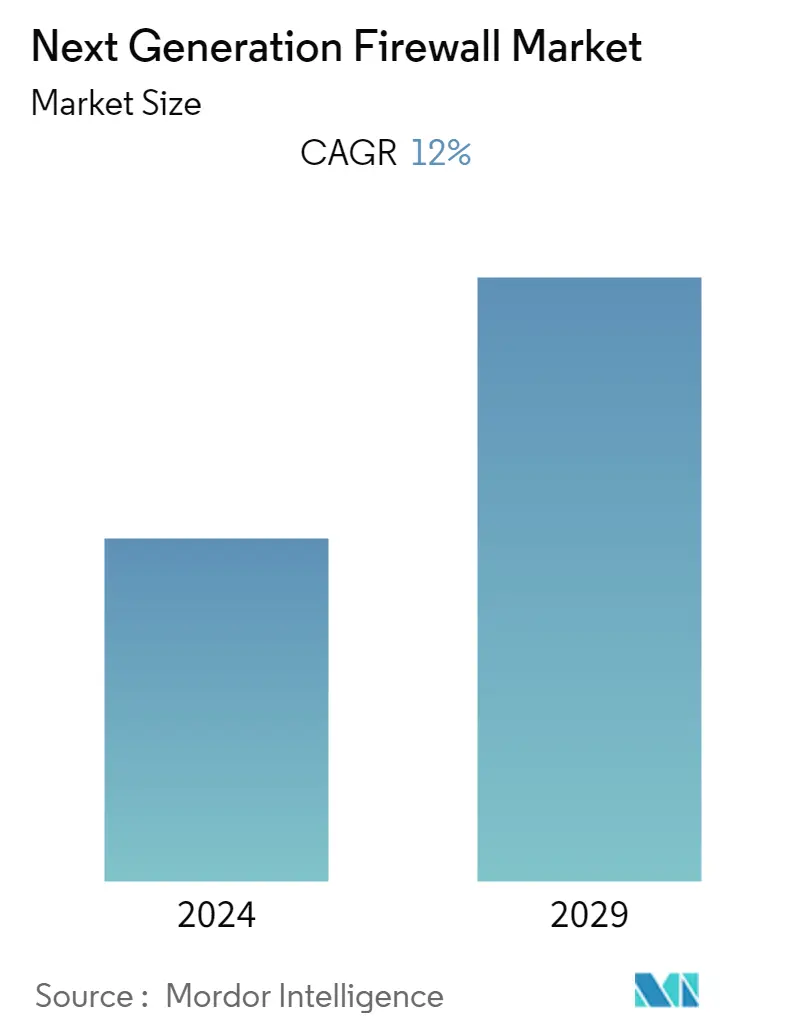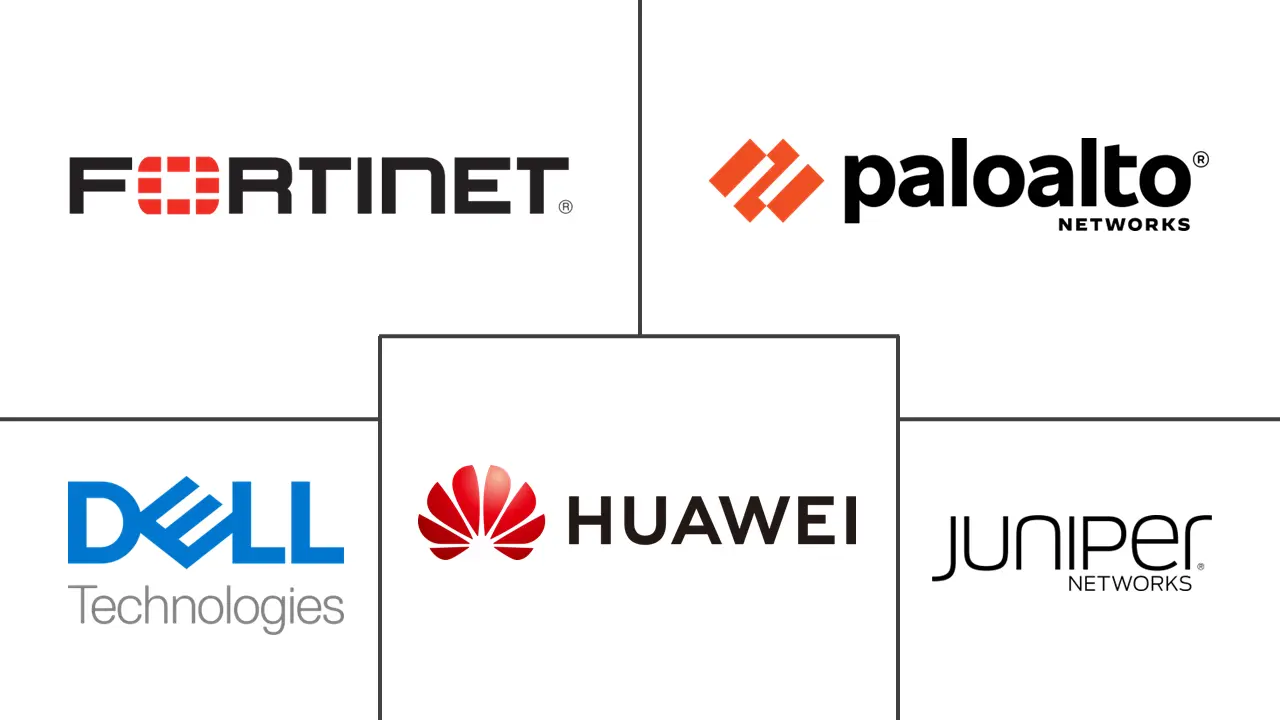Market Size of Next Generation Firewall Industry

| Study Period | 2021 - 2029 |
| Base Year For Estimation | 2023 |
| CAGR | 12.00 % |
| Fastest Growing Market | Asia Pacific |
| Largest Market | North America |
| Market Concentration | Medium |
Major Players
*Disclaimer: Major Players sorted in no particular order |
Next Generation Firewall Market Analysis
The next generation firewall market is expected to register a CAGR of 12% over the forecast period.
- One of the primary factors driving the growth of the next-generation firewall market is the rising global adoption of the Internet of Things. The increased adoption of next-generation firewalls for effectively managing logs while preserving the integrity and better business continuity and the increasing demand for dealing with massive amounts of computer-generated log data drive market expansion.
- Adopting next-generation security solutions helps increase the company's product and operational efficiencies. Machine learning, artificial intelligence (AI), and tighter network connectivity are used in next-generation endpoint security to provide more comprehensive and adaptable protection. Next-generation security systems use real-time user and system behavior analysis to examine executables. Existing security technologies advancing toward context-aware computing technology enable businesses to recognize sophisticated threats. Payment problems caused by system failures in IT infrastructure can disrupt global commerce, while network connection loss affects government functions such as law enforcement. Over the projected period, this aspect is expected to generate possibilities for next-generation firewall vendors.
- Internet-based cybersecurity tools are available and commonly utilized to defend cloud-based applications. More internet usage increases the likelihood of data breaches and simple data manipulation, which is impossible in an internal security system. As a result, organizations need to start using internet-based security solutions or revealing internet firewall management tools. Providers provide clear and multifactor safety solutions for an acceptable level of protection. Businesses must also plan for potential DoS (Denial-of-Service) attacks. However, it is relatively difficult to identify these attacks by security analytics solutions without proper protective measures and solutions. As a result, demand for next-generation firewall systems is likely to rise to maintain robust and efficient security systems.
- The companies are incorporating new applications/Solutions in their products to meet customers' demands. For instance, in July 2021, The FortiGate 3500F next-generation firewall (NGFW) was announced by Fortinet, a prominent player of comprehensive, integrated, and automated cybersecurity solutions, to defend enterprises with hybrid data centers from the ever-growing threat landscape and ransomware attacks. The FortiGate 3500F has some of the highest performance metrics in the business, incorporating TLS1.3 and automated threat protection after encryption. With its security-driven networking strategy, the FortiGate 3500F also includes zero-trust network access (ZTNA) capabilities, ensuring consistent security and a seamless user experience for any user at any location.
- Several constraints in the next-generation firewall market are preventing it from growing. A next-generation firewall is highly effective but expensive, making it difficult for medium-sized businesses to buy it. One of the primary constraints in the next-generation firewall is the high cost of systems. Because of the high cost of the systems, only large corporations can afford to use them. Another market limitation is that small and medium firms use traditional methods and antiquated technology and want to keep their technology the same, which constitutes a market restraint.
- Government agencies are allotting strategic funds to strengthen their digital interface in the post-pandemic era. For instance, In 2021, following recent hospital breaches, French President Emmanuel Macron announced a plan to invest EUR 1 billion (USD 1.2 billion) to strengthen cybersecurity in France, with EUR 350 million (approx. USD 400 million USD) set aside for hospitals.
Next Generation Firewall Industry Segmentation
A next generation firewall is a network security device that provides capabilities beyond a traditional firewall. While a traditional firewall typically provides stateful inspection of incoming and outgoing network traffic, a next-generation firewall includes additional features, like application awareness and control, integrated intrusion prevention, and cloud-delivered threat intelligence.
The next generation firewall market is segmented by enterprise size (small and medium enterprises and large enterprises), solution (cloud-based and hardware), end-user industry (government, healthcare, and BFSI), and geography(North America, Europe, Asia-Pacific, Latin America, Middle East and Africa).
The market sizes and forecasts are provided in terms of value (USD million) for all the above segments.
| By Size of Enterprise | |
| Small and Medium Enterprises (SMEs) | |
| Large Enterprises |
| By Solution | |
| Cloud-Based | |
| Hardware |
| By End-User Industry | |
| BFSI | |
| IT and Telecom | |
| Government | |
| Healthcare | |
| Manufacturing | |
| Retail | |
| Other End-User Industries |
| Geography | ||||||
| ||||||
| ||||||
| ||||||
| ||||||
|
Next Generation Firewall Market Size Summary
The next-generation firewall market is poised for significant growth, driven by the increasing global adoption of the Internet of Things and the need for robust cybersecurity solutions to manage vast amounts of log data. These advanced firewalls leverage machine learning, artificial intelligence, and real-time behavior analysis to offer comprehensive protection against sophisticated threats. The demand for these security solutions is further fueled by the rising incidence of cyberattacks, particularly in sectors like banking, financial services, and insurance, where the stakes are high due to the sensitive nature of the data involved. As organizations increasingly rely on internet-based applications, the necessity for effective firewall management tools becomes paramount to safeguard against data breaches and denial-of-service attacks.
Despite the promising growth trajectory, the market faces challenges, primarily due to the high cost of next-generation firewalls, which can be a barrier for medium-sized businesses. However, strategic investments by government agencies and the adoption of advanced security technologies by financial institutions are expected to drive market expansion. The North American region currently leads the market, supported by stringent regulations and a high demand for data security solutions. The market is moderately consolidated, with key players focusing on product innovation and strategic partnerships to maintain a competitive edge. Recent developments, such as Fortinet's cloud-native firewall and Palo Alto Networks' managed firewall service for AWS, highlight the ongoing efforts to enhance cybersecurity offerings and meet the evolving needs of businesses.
Next Generation Firewall Market Size - Table of Contents
-
1. MARKET DYNAMICS
-
1.1 Market Overview
-
1.2 Market Drivers
-
1.2.1 Rising Trend in the Migration from the Data Center to the Public Cloud
-
1.2.2 Growing Concern of Internal and External Threats Across Endpoint Devices
-
-
1.3 Market Restraints
-
1.3.1 High Cost of Installation across the Network System
-
-
1.4 Value Chain Analysis
-
1.5 Industry Attractiveness - Porter's Five Forces Analysis
-
1.5.1 Threat of New Entrants
-
1.5.2 Bargaining Power of Buyers/Consumers
-
1.5.3 Bargaining Power of Suppliers
-
1.5.4 Threat of Substitute Products
-
1.5.5 Intensity of Competitive Rivalry
-
-
-
2. MARKET SEGMENTATION
-
2.1 By Size of Enterprise
-
2.1.1 Small and Medium Enterprises (SMEs)
-
2.1.2 Large Enterprises
-
-
2.2 By Solution
-
2.2.1 Cloud-Based
-
2.2.2 Hardware
-
-
2.3 By End-User Industry
-
2.3.1 BFSI
-
2.3.2 IT and Telecom
-
2.3.3 Government
-
2.3.4 Healthcare
-
2.3.5 Manufacturing
-
2.3.6 Retail
-
2.3.7 Other End-User Industries
-
-
2.4 Geography
-
2.4.1 North America
-
2.4.1.1 United States
-
2.4.1.2 Canada
-
-
2.4.2 Europe
-
2.4.2.1 United Kingdom
-
2.4.2.2 Germany
-
2.4.2.3 France
-
2.4.2.4 Rest of Europe
-
-
2.4.3 Asia-Pacific
-
2.4.3.1 China
-
2.4.3.2 Japan
-
2.4.3.3 India
-
2.4.3.4 Rest of Asia-Pacific
-
-
2.4.4 Latin America
-
2.4.4.1 Mexico
-
2.4.4.2 Brazil
-
2.4.4.3 Rest of Latin America
-
-
2.4.5 Middle East & Africa
-
2.4.5.1 United Arab Emirates
-
2.4.5.2 Saudi Arabia
-
2.4.5.3 South Africa
-
2.4.5.4 Rest of Middle East & Africa
-
-
-
Next Generation Firewall Market Size FAQs
What is the current Next Generation Firewall Market size?
The Next Generation Firewall Market is projected to register a CAGR of 12% during the forecast period (2024-2029)
Who are the key players in Next Generation Firewall Market?
Juniper Networks Inc., Palo Alto Networks Inc., Dell Technologies, Huawei Technologies Co. Ltd and Fortinet Inc. are the major companies operating in the Next Generation Firewall Market.

